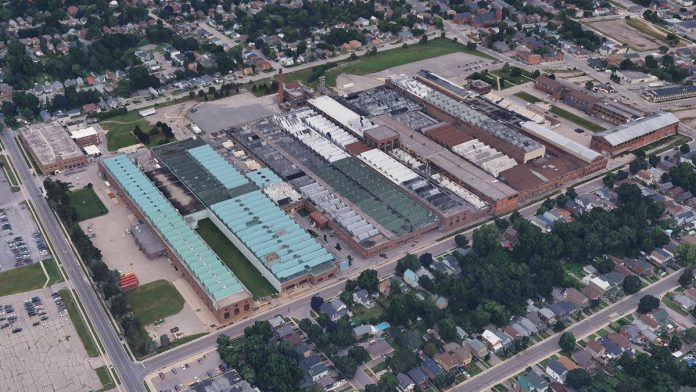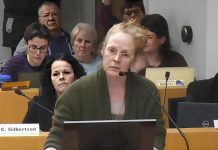
Despite hearing concerns from nine public delegations about the potential environmental and public safety impacts, Peterborough city council will allow GE Vernova to demolish a large number of vacant buildings at the historic General Electric factory complex at 107 Park Street North in downtown Peterborough.
At its meeting on Tuesday night (October 14), council spent four hours hearing from delegations and debating the issue before confirming a decision it made at general committee last Monday to reject a city staff recommendation that would have seen the city hire a consultant to conduct a peer review of a 154-page heritage impact assessment (HIA) report prepared by ERA Architects Inc. on behalf of GEPR Energy Canada Inc., a subsidiary of GE Vernova.
Instead, council decided to accept the recommendations made in the HIA report for which buildings should receive heritage designation, including two currently in use by GE Vernova, four currently in use by BWXT (an independent company that was originally part of GE Vernova’s nuclear energy division), and two unoccupied buildings with heritage value that will be retained and mothballed pending potential future uses.
That decision would allow GE Vernova to demolish and remove all other buildings in the complex’s centre block that haven’t been used since 2018. The 26 buildings to be demolished represent around 84,500 square metres (910,000 square feet) of the 104,000 square metre (1.1 million square feet) site.
On September 8, GE Vernova announced their demolition plans for the site by launching a website and mailing 4,500 letters to the neighbourhood. On the same day, the company sent the City of Peterborough a notice of intention for demolition. Because the entire GE complex is listed on the city’s heritage register for potential heritage designation, the city has 60 days under the Ontario Heritage Act — until November 7 — to advise GE Vernova whether the city plans to designate the property.
Most of city council was only made aware of the GE Vernova’s notice of intention for demolition just prior to the October 6 general committee meeting — 29 days after the city received the notice.
The proposed demolition is controversial because of known contamination of the industrial site with toxic hazardous substances over the past 125 years and the impact of a demolition on the safety of the surrounding residential neighbourhoods.
At Tuesday night’s meeting, council heard from public delegations including former GE employees, a lawyer whose firm specializes in asbestos exposure compensation, local residents, and a Toronto filmmaker, all of whom expressed concerns about the potential environmental and public safety impact of the proposed demolition.
Council also heard from the longtime chair of the Peterborough Architectural Conservation Advisory Committee (PACAC), who objected to city council’s decision to decide on heritage designation for specific buildings without first consulting with the citizen-led municipal committee of local heritage experts.
Prior to hearing from public delegations, Mayor Jeff Leal made a statement about the environmental concerns of the proposed demolition.
“As the chair of this meeting is my obligation to ask delegations to speak to the matter which is on the agenda tonight, which is the question of the heritage considerations related to the GE property,” the mayor said. “The issue of the demolition permit is a subject of the provincial regulatory requirements under the Building Code Act administered by the (city’s) chief building official.”
“I will give some latitude this evening to residents because this is an important forum for our community, but I would also ask questions etc. to stay on topic. I understand the concerns of many residents who worry about the demolition plan and the disposal of potentially hazardous materials if a demolition permit is granted. I had many chats with citizens in Peterborough on this topic at the farmers’ market this past Saturday.”
“That’s why I’ve asked the Honorable Todd McCarthy, minister of the environment, conservation and parks, and (Peterborough-Kawartha) MPP Dave Smith to meet with me regarding the ministry’s role in managing the GE site. Questions and concerns about this important demolition and its impact on our community are vitally important to all, but environmental controls on the property are outside of the jurisdiction of the municipality and not within the scope of issuing a demolition permit under the Ontario building code. GE Verona and the provincial government, specifically the minister of the environment, conservation and parks, will be responsible for addressing environmental concerns.”
The first public delegation on this issue was Susan James of the Peterborough Occupational Disease Action Committee, a volunteer-led advocacy group which led a fundraising effort to install a monument in Millennium Park in June in the memory of GE employees and others who died of illnesses related to their jobs. James, who followed in her father’s footsteps and worked at GE for 40 years, lost her father to lung cancer in 1996.
“By demolishing the centre block, (GE Verona) will be destroying the final piece of evidence of the toxic and lethal legacy of workers’ history,” James said. “The importance of decommissioning any structure of this size and impact it would have on the neighbouring community should be carefully questioned and thought out.”
Deirdre McGahern, who is the owner of the straw bale construction company Straworks Inc., lives on Patterson Street just 500 feet away from the site. She says she was “alarmed” when she received a notice from GE Verona about the proposed demolition, noting that she renovated her home “with great care for health and the environment.”
“The proposed demolition raises serious concerns about the release of airborne contaminants, including asbestos fibers, chemical dust, PCBs, trichloroethylene into the neighborhood and the wider Peterborough community,” McGahern said.
“What I’m witnessing is a profound failure of the regulatory system to protect public health from historical industrial contamination — contamination that threatens residents like myself if this demolition is approved. At council last week, I learned that no provincial, municipal, or federal laws under the Building Code Act provide mechanisms to protect public health or prevent environmental exposure during the demolition of contaminated industrial buildings.”
Husband and wife Robert DeMatteo and Dale DeMatteo of the Peterborough Occupational Disease Action Committee, who were involved in the 2017 Unifor report that details the toxic chemical exposures at the General Electric site between 1945 and 2000, provided council with some numbers about the use of toxic substances at the site, noting that 3,000 hazardous chemicals were used daily, 40,000 pounds of lead were used weekly, and 500 pounds of asbestos were used daily.
“We state, without reservation, that demolishing these buildings will put the community at great risk of exposure to highly toxic residues in the form of dust, particulate mists, gases, liquids, and vapors,” Dale said. “Post 9/11 health studies document residents living near the World Trade Center as developing serious respiratory and digestive system illnesses associated with exposure to asbestos and other toxic chemicals.”
“GE has responsibility to clean up the contaminated aftermath of a very prosperous 100-year enterprise. In stating up front that their demolition request is to reduce GE’s (property) tax burden, the company in effect will shift long-term responsibility for the proposed cleanup to local taxpayers. GE’s financial and moral obligations to the municipality of Peterborough should be established prior to making any decision on the fate of these buildings.”
The next delegation was PACAC chair Stewart Hamilton, who has spent 15 years on the municipal heritage committee including 14 as chair. Reiterating a statement he made in a letter to council the previous week, he said that PACAC is requesting that council support the city staff recommendation for an independent review of the HIA report and that the entire matter be sent to PACAC for review prior to council making any decision.
“It’s important I think that we as a municipality rely upon our own experts, and that we take this information knowing that is was prepared for the property owner and their use — it wasn’t prepared for our use,” Hamilton said in response to a question from councillor Joy Lachica. “I think it’s important that we rely upon our own experts and we do our due diligence to make sure the information represents our interests.”
Lachica also asked Hamilton whether the listing of the GE property on the heritage register includes all the buildings on the site, and whether an attempt to delist some of the buildings on the property would be an attempt to delist the entire property. Hamilton answered yes to both questions.
Daniel Miskin of Miskin Law, which works on class-action lawsuits involving harmful products, toxic exposures, and other large-scale legal issues, told council that “Peterborough will pay the price once more” if demolition goes ahead, noting that demolition under the building code “was never designed to deal with chemical contamination.”
“Following the building code doesn’t make this demolition safe without proper environmental testing,” Miskin said. “Those same toxins can spread through the air, the water, and our neighborhood. When these buildings come down, asbestos will not stay contained — it will travel. There’s no safe level of exposure. Even a single fiber can cause cancer.”
“Materials like plaster, drywall, pipe insulation, and even the mortar in the bricks of the building can contain asbestos. When they’re torn apart, that just drifts through the air onto nearby homes and towards the school across the street. Even brief exposure increases lifetime cancer risks. For every 100 people breathing the dust, several could develop an asbestos-related disease decades from now. That’s not acceptable when it’s preventable.”
Miskin noted that the ministry of the environment issued a director’s order in March 2024 confirming contamination of the soil and the groundwater with PCBs, trichloroethylene, vinyl chloride, and other carcinogens, and that PCBs have already reached Little Lake, contaminating sediments, and solvent vapors continue to rise through the soil.
“The order requires GE to contain and treat these toxins, and demolition risks breaking those systems and releasing what they were meant to hold,” Miskin said. “The ministry’s oversight is limited to containment, not cleanup. The order does not address demolition or full remediation. As long as the caps remain, the ministry considers its duty done, and that’s not protection — that’s postponement.”
“This council has both the authority and obligation to act. With the Municipal Act, you have the power to protect health, safety, and the well-being of residents. Section 97.1 allows you to regulate site alteration, including demolition and soil disturbance. The Supreme Court of Canada confirmed that municipalities can impose stricter environmental protections than the province when residents are at risk.”
“You can call on the ministry to expand the director’s order to include demolition, oversight, and full remediation. You can delay or deny any demolition permits until the ministry confirms that no breach will occur. You can require GE to post an environmental bond to cover up cleanup costs if contamination spreads. The authority exists. It’s written into law. The question is whether you will use it.”
“If you sit on this council and you cannot take the time to understand the legal tools available to you, then you should not be making decisions that affect public health. Ignorance and inaction here are not harmless — they will cost lives … General Electric poisoned this community for decades and then walked away. If this council does nothing, you are complicit in the next generation’s exposure. History will remember whether this council acted or turned away.”
Council heard delegations from four other Peterborough residents — Jane Scott, Bill Templeman, Marie Bongard, and Dr. Micky Renders — expressing their concerns about the proposed demolition.
Council also heard a remote delegation from Toronto resident Natasha Luckhardt, producer and director of the 2019 documentary Town of Widows with local filmmaker Rob Viscardis about the fight for justice by former GE workers and their widows in Peterborough who believe illnesses and cancer deaths in their community are linked to toxic exposure from the GE plant.
Luckhardt, who is also director of health, safety and environment at the Ontario Federation of Labour, spoke about her personal experiences making the film. She said she was “extremely disappointed in those who voted in favour” of the demolition, addressing Mayor Leal directly with respect to his involvement in the film meeting with GE workers.
“A vote against this demolition is a vote for this community,” Luckhardt said.
Following the delegations and a vote on consent items, council debated the motion.
Councillor Matt Crowley asked city staff what provincial safeguards are in place around airborne contaminants released during demolition of contaminated sites. Acting chief building officer Jody Drumm said there is no enforcement in the building code to address the issue of airborne pollutants, and that the property owner would have to consult with the ministry of environment if there is contamination.
Commissioner of legislative services David Potts addressed Crowley’s question by noting the prescribed role of the city’s chief building officer and pointing out that the Municipal Act “expressly prohibits” trying to regulate the demolition permit process by Municipal Act by-law and to “disregard the advice,” presumably referring to the earlier point made by Miskin when he was making his public delegation.
Potts also outlined regulations under the Environmental Protection Act with respect to airborne contaminants during a demolition, as well as management of demolition waste.
In response to a question from Crowley about whether council’s decision on demolition is in contravention of the Ontario Heritage Act, Potts said there has been a lot of “misleading information” in media coverage, adding that “there is no process to delist the property” and that council’s motion to make an initial determination is “precisely within the scope” of the legislation as council’s recommendation will be referred to PACAC for consultation.
In response to a question from councillor Dave Haacke about whether the GE property is being delisted from the heritage register, Potts said “It’s not true.”
Councillor Lachica raised a point of order, pointing out to Potts that PACAC listed the entire property on the heritage register, so if council decides to allow demolition of some of the buildings on the property, it is delisting those buildings.
“(My role before council) is to advise, it’s to provide legal advice, it’s not really a forum for debate, for a number of reasons,” Potts replied.
Councillor Alex Bierk put forward an amendment to the motion requesting that “city staff come back to council with an outline for a health and safety plan for the GE site and its broader impacts,” in response to concerns put forth by residents. He also proposed that council vote down the motion amended at general committee, reverting to the original staff recommendation for a peer audit of the HIA report commissioned by GE Vernova.
After further discussion of Bierk’s amendment, mainly around the wording and what it implies, council voted 6-5 in favour of the amendment, with Mayor Leal and councillors Haacke, Lesley Parnell, Kevin Duguay, and Gary Baldwin voting against.
After councillor Keith Riel asked for the four items of the amended motion to be separated out for voting, council debated the amended motion, with councillor Lachica stating that the second item — where council recommended heritage designation of specific GE buildings — should be ruled out of order as it would in effect delist the buildings that would be demolished on the property, which is listed in its entirety on the heritage register.
After further discussion, councillor Duguay called the question (a procedural tactic to end debate and force a vote) and council voted 6-5 in favour, with councillors Lachica, Bierk, Don Vassiliadis, Baldwin, and Riel voting against.
On the first item of the motion, that council acknowledge receipt of the notice of intention to demolish the buildings, council voted 9-2 in favour, with councillors Lachica and Bierk voting against.
On the second item of the motion, that council indicate to GE Vernova that it has no interest in pursuing heritage designation of 107 Park Street North with the exception of buildings 2, 2A, 8A, 21, 24A, 26, 28, and 30, councillor Lachica raised a point of order saying that the item is out of order because it would in effect delist other buildings that are part of the heritage register’s listing for the entire GE property without PACAC’s involvement as required under the Ontario Heritage Act.
After Mayor Leal ruled the item in order, Lachica challenged the chair. Council voted 8-3 to sustain the chair’s ruling, with Lachica, Bierk, and Riel voting against.
Council then voted 6-5 in favour of the second item, with Lachica, Bierk, Riel, Crowley, and Baldwin voting against.
On the third item, that council direct staff to consult with PACAC and report back to council on the buildings proposed for heritage designation, council voted 10-1 in favour, with councillor Riel voting against.
On the fourth and final item, that city staff come back to council with an outline for a health and safety plan for the GE site and its broader impacts, council voted unanimously in favour.
In other business at the end of the meeting, Mayor Leal told council he would be reaching out to the minister of the environment “ASAP” for a meeting to discuss the environmental issues related to the GE demolition, before sharing a personal story.
“There was somebody that I loved dearly, who retired from GE in April of 1982 after 40 years of service,” the mayor said. “He died of lung cancer in October of 1983. That was my dad, so anybody around this table that doesn’t think that I don’t understand this issue, you’re dead wrong.”
“I also dealt with all the WSIB (Workplace Safety and Insurance Board) cases. You know what it’s like sitting in an office with a widow who says to you that my husband had a death from esophageal cancer, the most painful depth that one can endure from cancer, and I don’t understand? I understand her very well. And nobody that I know as a monopoly on virtue, that they care more than others.”
Mayor Leal sends letter to the Minister of Environment, Conservation and Parks
On Wednesday (October 15) following the council meeting, the City of Peterborough released a letter sent by Mayor Leal to Todd McCarthy, Ontario’s minister of environment, conservation and parks, that outlined council’s ratified motion, the demolition and heritage plan, and the need to deal with potential contaminants during demolition.
“Because of the toxicity of this site, we believe that the full weight of the Environmental Protection Act needs to be applied,” the mayor wrote in part. “Ontario Regulation 347: General – Waste Management and within the Environmental Protection Act speaks to the need for testing, characterization, classification, transportation and disposal of waste related to the demolition process. We also recognize that the Ministry of Labour will have a significant role to play in the demolition process. ”
“The Ministry of the Environment, Conservation and Parks has indicated that meetings with GE Vernova, Lakelands Public Health, and the City of Peterborough will take place prior to demolition activities. This will promote transparency and a flow of information to the residents of Peterborough. It would be helpful to have a designated individual from your staff based in Peterborough as the point of contact on this file.”
Leal also offered to meet with Minister McCarthy at his constituency office in Bowmanville or at his Toronto office.
This story has been updated with information about Mayor Jeff Leal’s letter to the Minister of Environment, Conservation and Parks.


























